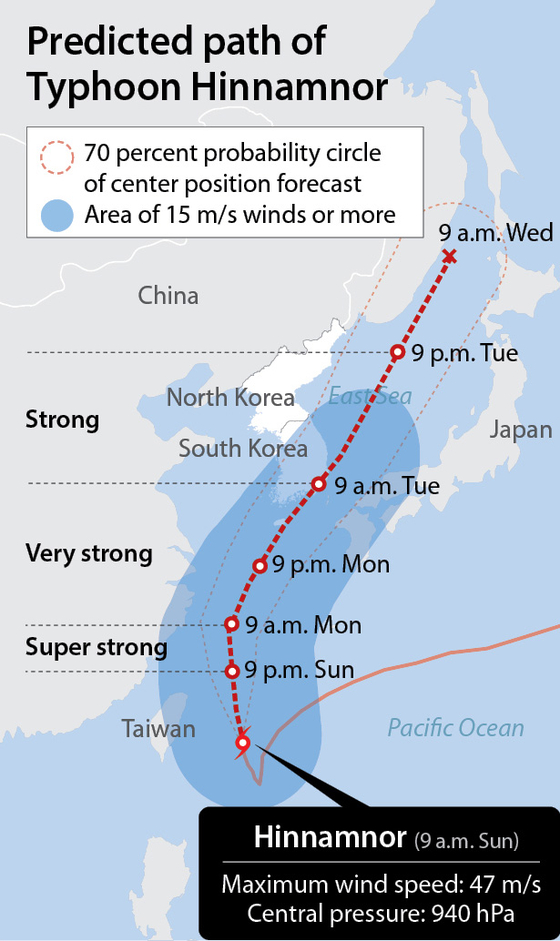Korea braces for Hinnamnor, Busan in the path of the eye
![Fishing boats docked in Busan Port on Sunday as the nation braces for Typhoon Hinnamnor. The Korea Meteorological Administration warned that the typhoon could turn out to be the strongest to hit Korea in decades. [SONG BONG-GEUN]](https://koreajoongangdaily.joins.com/data/photo/2022/09/05/aaba59df-934e-44af-8e6f-33d97559f03e.jpg)
Fishing boats docked in Busan Port on Sunday as the nation braces for Typhoon Hinnamnor. The Korea Meteorological Administration warned that the typhoon could turn out to be the strongest to hit Korea in decades. [SONG BONG-GEUN]
The Korea Meteorological Administration (KMA) announced Sunday that the typhoon — which could turn out to be the strongest to hit Korea in decades — was expected to pass through Jeju waters early Tuesday morning and pass near Busan hours later.
How strong the typhoon will be by the time it arrives near Busan, Korea’s second-most populous city, is unclear, the KMA said.
Using currently available data, the typhoon is predicted to be a “strong” typhoon — the third-strongest of the KMA’s four typhoon categories.
According to the KMA, a strong typhoon is enough to derail trains and send sign boards and rooftops flying, though not enough to cause people and large stones to fly and damage buildings.
But strong winds will be felt within a 380-kilometer (236-mile) radius, enough to reach the Seoul metropolitan area, the KMA said.

Maximum wind speeds are forecast to reach 40 to 60 meters per second (89 to 134 miles per hour) from Monday night to early Tuesday morning on Jeju Island and the southern areas of mainland Korea, where the intensity of Hinnamnor is expected to be greatest.
If maximum wind speeds reach above 60 meters per second, the KMA noted that Hinnamnor will break Korea’s record as the most powerful typhoon to strike the country.
To date, the strongest typhoon felt in Korea was Typhoon Maemi in September 2003, when winds of up to 60 meters per second were felt on Jeju Island.
Maemi resulted in 132 people dead or missing and over 4 trillion won ($2.94 billion) worth of damages.
The deadliest typhoon that Korea experienced in modern history was Typhoon Sarah in 1959, which resulted in 849 people dead or missing.
The KMA said in a statement that the greater Seoul area, southern coastal areas and Jeju Island are forecast to experience 20 to 30 millimeters (0.8 to 1.2 inches) of rain per hour with strong winds, thunder and lightning on Sunday.
Heavy rains of 50 to 100 millimeters per hour will pound on the greater Seoul area, western and northern Gangwon and northern South Chungcheong on Monday and on the rest of the country Tuesday.
By Tuesday, the predicted cumulative precipitation across most of the country will be 100 to 300 millimeters. A cumulative amount of more than 400 millimeters of rain is predicted to fall in the southern coastal areas, northern Gyeonggi, western Gangwon, eastern coastal areas of the Gyeongsang provinces, Jeju Island and Mount Jiri areas. In the mountainous region of Jeju Island, more than 600 millimeters of rain is predicted to fall by then.
On Sunday at 9 a.m., Hinnamnor was spotted 320 kilometers east-northeast of Taipei, moving north at a speed of 18 kilometers per hour. The central pressure was 940 hectopascals (hPa) with maximum speeds of 47 meters per second, making it a “very strong” typhoon, the second-highest of the KMA’s four typhoon categories.
A very strong typhoon, which has maximum winds of 44 to 54 meters per second, is enough to send people and large stones flying, the KMA notes.
A super strong typhoon, the highest category, has maximum winds of 54 meters per second or above and is enough to damage buildings.
The KMA on Sunday warned that tides near Korea’s southern coastal areas could rise above 10 meters, while urging communities in these areas to take precautions. Across the country, weather officials warned the public not to go outside and check for any signboards or rooftops that could fly away in the strong winds.
In South Gyeongsang, shop and restaurant proprietors stacked sandbags near their businesses on Sunday and scurried to move their equipment to safer locations. All schools in the province will hold remote classes on Tuesday.
Educational officials in Busan said they were persuading schools to either hold remote classes from Monday through Wednesday, don’t hold any classes at all during the period or adjust in-person class hours.
In Jeju, virtually all schools are holding remote classes on Monday and Tuesday, reducing in-person class hours or temporarily closing.
Sea routes linking Jeju Island and other coastal cities were mostly closed Sunday.
Korean Air announced Sunday that all domestic flights flying to and from Jeju Island will be canceled on Monday from 1 p.m., while all flights flying to and from Busan’s Gimhae International Airport will be canceled from 6 p.m. on the same day.
Asiana Airlines said all flights going to and from Jeju Island and Yeosu in South Jeolla will be canceled from 1 p.m. on Monday.
BY LEE SUNG-EUN, CHON KWON-PIL [lee.sungeun@joongang.co.kr]










with the Korea JoongAng Daily
To write comments, please log in to one of the accounts.
Standards Board Policy (0/250자)